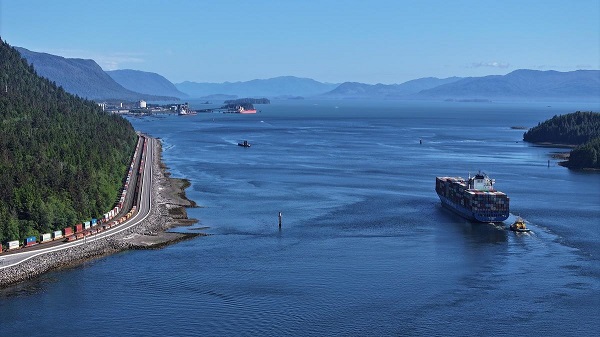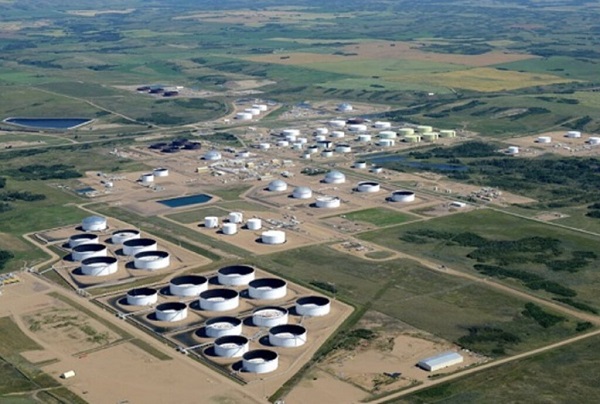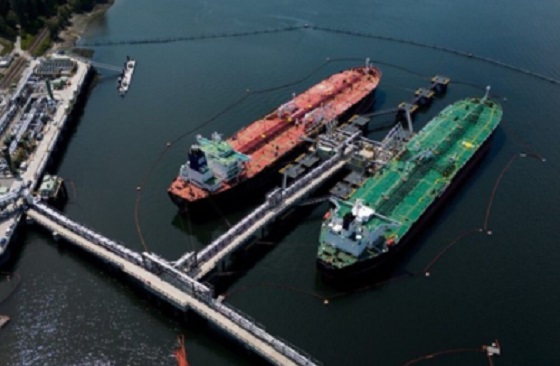Alberta
Pray for better days – a 3rd generation oil worker laments the end of an industry

by Sheldon Gron (published with permission)
I’ve been debating on whether or even how to write this over the last few weeks. I’m a third generation oilfield worker, a large portion of my family being involved with the oilfield in some way. Its sad to say, but I really truly honestly feel that the oilfield in Canada is officially dead. Sure there will be a little here and there, some guys will get a little work and even less will get consistent work, but all in all, to be an oilfield worker as a career is over. Nothing pains me more than to be saying this as I myself have over 20 years in the industry, an industry which I used to love and was proud to be apart of.
The industry has always worked in cycles, most of us know this. It was feast or famine. Best you could do was get the money while the gettin’ was good and save the best you could to prepare for the next slow down. Some were smart, most were not. Debt would ring up, slow down would hit and more debt would add up until bankruptcy loomed. Most slow downs lasted at most a year but usually turned around and guys would get 3 or 4 years of good times to recover and prepare for the next one. Take this most recent slow down in 2014. Writing was on the wall BUT no one expected it to hit as hard as it did. The world shook as oil prices fell to near 1998 prices. Within a few years though prices started to climb, enough so that work started to return. Not a ton, but enough that the guys left in the patch were finding work.
2018 there was finally some hope, there seemed to be some sort of light at the end of the tunnel but this whole pipe line mess loomed over us. You see Canadian Crude has always had its own value, lately a value significantly lower that everyone else due to our lack of infrastructure to get oil to market. With our current government and their apparently efforts to stop the much needed pipe line, Western Crude prices fell, investments pulled and companies lost faith… Canada is now suffering another oilfield crash, on top of the previous one. Heres the problem.
Anyone that has survived thus far is at the end of their rope. Toys are sold, saving have been spent to survive these last 4 years and now that another slow down is here, there is nothing to fall back on. Faith in the patch is gone as the hands and small businesses are in real trouble this time.
We are 8-10 year away from any of this ever turning around at the earliest, save some major event happening that sends oil to 200 a barrel. Lets face it, without a means to get our oil to market, no one wants it and who can blame them. Our government has severely let us down and 2019 is going to mean some serious trouble for Canada. I have done every thing I can to stick it out in the only career I know and don’t know how much longer I can go living pay check to pay check meanwhile being away from my family 25 days a month just to get by, and thats when I’m busy. If I was young and new to the oilfield I wouldn’t come anywhere near the oilfield as its apparent there is no future. You used to come here to make money, now, when you can actually get work, the money isn’t that great anymore.
I know some of you have very little sympathy for oilfield workers because you have always seen the money they have made but let me explain the repercussions of no oilfield in Alberta, Sask or Northern BC. Before the crash, entry level oilfield workers made over 100K a year. In order to do this they usually spent about 230-250 days a year away from their friends and families in all weather conditions working all sorts of hours. At times these conditions could be some of the most gruelling with sometimes not the nicest people. But it was a job and it paid well. That’s from their perspective. These same people that do this job pay 30% or more in taxes to our government. They pay more in taxes that many people make in an entire year, thats entry level, now take the people that are pulling in 200-250K. All that tax money is gone, no longer paying for schools and hospitals and roads and such. Now consider those lifted trucks and toys they buy with the money they earned with their oilfield money. All that money went to local businesses and local people that didn’t work in the oilfield. Salaries were paid, cloths were bought with that money those people earned from selling that truck or quad or what ever they buy.
Also consider the money they spent in the places they worked, supporting locally. Hotels, gas stations and grocery stores, restaurants and bars and so on. Alberta was successful and one of the richest provinces for one reason, OIL MONEY and now it is gone. Go to another have not province and ask them what its like to not have jobs and see what they think. Ask the number of people born across Canada that have come to Alberta for the Alberta Advantage why they came. Our Federal government had one mission regarding Alberta, and that was to bring it to its knees and we have let them do it. The oil field is dead and we let it happen. They panic cause 2500 of Ontarios people lost their jobs because GM shut down a plant yet 150K Albertans have lost their jobs and more are coming.
Alberta
Alberta government records $8.3 billion surplus—but the good times may soon end

From the Fraser Institute
By Tegan Hill
According to last week’s fiscal update, the Smith government recorded a $8.3 billion surplus in 2024/25—$8 billion more than what the government projected in its original 2024 budget. But the good times won’t last forever.
Due largely to population growth, personal income tax revenue exceeded budget projections by $500 million. Business tax revenue exceeded budget expectations by $1.1 billion. And critically, thanks to relatively strong oil prices, resource revenue (e.g. oil and gas royalties) saw a $4.7 billion jump.
The large budget surplus is good news, particularly as it will be used to pay down government debt (which taxpayers must ultimately finance) and to invest for the future. But again, the good times could soon be over.
Recall, the Alberta government incurred a $17.0 billion budget deficit just a few years ago in 2020/21. And it wasn’t only due to COVID—until the recent string of surpluses, the government ran deficits almost every year since 2008/09, racking up significant amounts of debt, which still largely persists today. As a result, provincial government debt interest payments cost each Albertan $658 in 2024/25. Moreover, in February’s budget, the Smith government projected more deficits over the next three years.
Generally, Alberta’s fiscal fortunes follow the price of oil. Over the past decade, for example, resource revenue has been as low as $2.8 billion in 2015/16, while oil prices slumped to $US45.00 per barrel, and as high as $25.2 billion in 2022/23, when oil prices jumped to $US89.69 per barrel.
Put simply, resource revenue volatility fuels Alberta’s boom-and-bust cycle. In 2025/26, the West Texas Intermediate oil price will be a projected $US68.00 per barrel with projected resource revenue falling by $4.9 billion year-over-year.
But oil prices don’t need to dictate Alberta’s fiscal fortune. Indeed, if the Smith government restrains its spending, it can avoid deficits even when resource revenues fall.
There are plenty of ways to rein in spending. For instance, the government spends billions of dollars in subsidies (a.k.a. corporate welfare) to select industries and businesses in Alberta every year despite a significant body of research that shows these subsidies fail to generate widespread economic benefit. Eliminating these subsidies is a clear first step to deliver significant savings.
The budget surplus is undoubtedly positive for Albertans, but the good times could soon come to an end. To avoid deficits and debt accumulation moving forward, the Smith government should rein in spending.
Alberta
Alberta Provincial Police – New chief of Independent Agency Police Service

Sat Parhar has been appointed as the first chief of the Independent Agency Police Service, marking the next step toward a new municipal policing option.
The appointment of a new chief for the Independent Agency Police Service (IAPS) marks the next step in giving municipalities a new option for local policing and builds on the work already underway for the agency to assume the police-like duties currently carried out by the Alberta Sheriffs. The IAPS will empower municipalities to adopt strategies that effectively respond to their specific safety concerns, enhancing public safety across the province.
Chief Parhar brings more than 25 years of policing experience, including senior roles with the Calgary Police Service, most recently as deputy chief. His frontline policing experience and deep understanding of Alberta’s complex and diverse public safety landscape positions him to lead the agency as it takes shape and begins its work as a new municipal policing option, keeping communities safe.
Once operational, the agency will strengthen Alberta’s existing policing model and complement the province’s current police services, which includes the RCMP, Indigenous policing services and municipal police. It will help fill gaps and ensure law enforcement resources are deployed efficiently to meet Alberta’s evolving public safety needs and improve law enforcement response times, particularly in rural communities.
“Appointing Chief Sat Parhar is a key milestone in Alberta’s plan to give municipalities a real choice in how their communities are kept safe. This is about building a modern police service that reflects the priorities of Albertans, strengthens local decision-making, and ensures every corner of our province, especially rural areas, can count on responsive, effective law enforcement. With his decades of experience and deep understanding of Alberta’s policing landscape, he is the right leader to bring this vision to life.”
“This appointment signifies a significant step forward in our efforts to establish a more robust, community-focused policing model that is better equipped to meet the unique needs of our local residents. Under Chief Parhar’s visionary leadership, we are confident that we will develop a modern, efficient police service that not only enhances public safety but also aligns closely with the priorities and values of Albertans. His experience and commitment are vital in shaping an IAPS that is responsive, transparent, and dedicated to fostering trust and collaboration within the community, ultimately ensuring a safer and more connected society for all.”
Chief Parhar’s immediate priorities will be to hire an executive team and commence organizational planning such as developing key recruitment, training and other operational policies. Chief Parhar’s appointment is the first step of many to establishing the IAPS.
“It’s an honour to take on this role and help shape a modern police service built for Alberta. My focus from day one will be on setting high standards for professionalism, building strong relationships with our partners and ensuring this service reflects the needs and priorities of the communities we serve.”
The Independent Agency Police Service was formally created through regulation following the passing of Public Safety Statutes Amendment Act, 2024. The agency will operate as an independent Crown corporation, and will be renamed the Alberta Sheriffs Police Service, with its head office located in Calgary. The IAPS will be operationally independent from the provincial government with civilian oversight, consistent with all police services in Alberta.
“When it comes to policing, municipalities like ours deserve a choice – especially when the current system leaves us disadvantaged simply because of our size. We look forward to learning more about what that alternative will look like once an Alberta police agency is fully established and the options are clear. For us, this is about fairness, sustainability, and ensuring municipalities have access to policing solutions that reflect both their needs and their realities.”
Quick facts
- The regulation establishes the IAPS Provincial Corporation and its governance structure including board of directors, board of director powers, financial responsibilities and accountabilities.
Related news
- Expanding municipal police service options (April 7, 2024)
-

 Business2 days ago
Business2 days agoLatest shakedown attempt by Canada Post underscores need for privatization
-

 Business2 days ago
Business2 days agoWhy it’s time to repeal the oil tanker ban on B.C.’s north coast
-

 Aristotle Foundation2 days ago
Aristotle Foundation2 days agoHow Vimy Ridge Shaped Canada
-

 Alberta1 day ago
Alberta1 day agoPierre Poilievre – Per Capita, Hardisty, Alberta Is the Most Important Little Town In Canada
-

 MxM News1 day ago
MxM News1 day agoUPenn strips Lia Thomas of women’s swimming titles after Title IX investigation
-

 Alberta1 day ago
Alberta1 day agoAlberta Provincial Police – New chief of Independent Agency Police Service
-

 Energy2 days ago
Energy2 days agoIf Canada Wants to be the World’s Energy Partner, We Need to Act Like It
-

 International2 days ago
International2 days agoCBS settles with Trump over doctored 60 Minutes Harris interview









